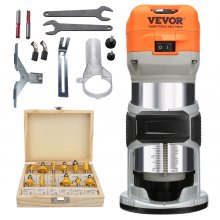












Usually made of wood, metal, or plastic, a plunge router is positioned directly on the surface of the object being cut. The cutter is lowered gradually into the work and begins to cut into it when the motor is switched on.
Now introduce yourself to VEVOR Plunge Routers, the hidden heroes of the woodworking industry. These routers symbolize a new era in workmanship, standing strong in an era where innovation and tradition combine.
Several plunge routers are available, each tailored to the unique requirements and inclinations of artisans and woodworkers. Selecting the ideal plunge router becomes easier if you know the various types available.
The most popular plunge routers are the electric-powered plunge routers, which draw power from a regular power socket. They are appropriate for various woodworking jobs, from simple routing to more complex designs, and they provide continuous power.
Unlike electric-powered models, cordless plunge routers are more portable and offer more mobility thanks to their rechargeable battery technology.
They are perfect for use when working on tasks outside or in places where there may not be a direct connection to a power outlet.
Pneumatic plunge routers run on compressed air. They are typically found in industrial environments or workshops with air compressors. Because of their high power, they are favored for demanding routing jobs that require prolonged usage.
Compared to normal models, compact plunge routers are lighter and smaller, which makes them easier to handle and operate, particularly for detailed or intricate work.
For professionals who need a more flexible router for precise routing jobs, they are perfect for do-it-yourself enthusiasts, hobbyists, and DIY enthusiasts.
You must consider several variables to choose the best plunge router for your needs and preferences. Here's a guide to assist you in making a wise choice.
Take into account the motor's power rating for the plunge router. Better performance usually correlates with higher power, mainly when working with thicker or harder wood. Seek for routers with strong motors that can continue to cut well and at a constant pace even while under strain.
Take note of the plunge router's depth adjustment system. Look for routers featuring simple-to-use depth adjustment functions to ensure accurate depth control and speedy adjustments while operating. A depth adjustment system must be smooth and dependable to achieve precise cuts.
Evaluate the plunge router's build quality and durability, considering the materials it was made of and the general robustness of its parts.
Select a router with long-term dependability constructed from high-quality components that can resist frequent use.
Choose a plunge router with this feature so you may change the router's speed based on the kind of bit being used and the material being routed. Variable speed control provides greater versatility and the ability to accomplish optimal results with various routing jobs.
Verify whether the plunge router is compatible with add-ons, including dust-collecting systems, edge guides, and router bits. Make sure the router has the capabilities and attachments that will allow it to accept your favorite accessories so you may improve and personalize its performance for various routing applications.
Although woodworking requires significant effort and commitment, the results may be astounding, particularly with the correct tools.
When you first start in woodworking, there are several items you should make sure you have and look for. A router will be one of these items.
One essential instrument in a woodworking setting is the router, which you will continue to use long after you have learned the craft.
Because routers are such flexible instruments, it is even more crucial to spend your money on the one that best suits your needs.
A router with a fixed style never moves. They operate better on the outer edges of the wood because they are more maneuverable and accurate.
Plunge routers are far more versatile, perfect for intricate designs, and can quickly vary the cutting depth while still making cuts in the center of the wood.
It's essential to familiarize yourself with the two types of routers because selecting the incorrect one can result in several issues.
For those who need to be more skilled in carpentry, fixed-base routers are fantastic. This router ranks as one of the best openers to the equipment used in woodworking, especially since it is a relatively small power tool or requires a lot of materials.
When you need to control the thickness of the cutting bit precisely, plunge routers are fantastic. After all, plunge routers are made to function according to the initial force applied to the cutting bit.
Purchasing VEVOR plunge routers ensures the success of your woodworking project. Renowned for their durability and precision engineering, VEVOR routers provide unparalleled performance for pros and enthusiasts.
Thanks to their strong motors and flexible speed control, they can easily handle a broad spectrum of routing chores, from basic edging to complex patterns.
The dependable depth adjustment mechanism guarantees accurate cuts every time, and the user-friendly layout ensures comfort throughout extended usage. Select VEVOR for each job if you want unmatched performance, accuracy, and dependability.
Although plunge routers can be frightening at first, they are relatively simple to use with the right training and experience. Most products include user guides and safety instructions to assist consumers in getting started. Before beginning any woodworking job, you must become acquainted with the instrument and practice using waste material.
Although cutting wood is the main application for plunge routers, they also can cut plastic, acrylic, and some metals. The appropriateness of the plunge router for the work will depend on the kind of material and the particular router bit being used.
It is possible to mount many plunge routers on router tables for increased control and stability. However, it's important to verify the router's specs and compatibility before using it on a router table, as not all plunge routers are compatible.